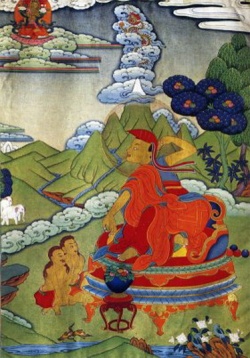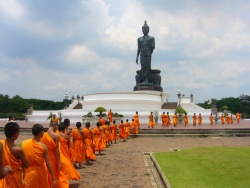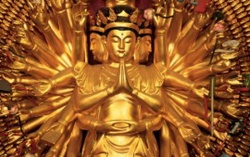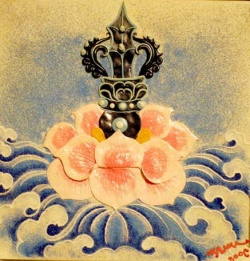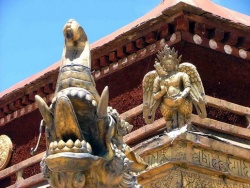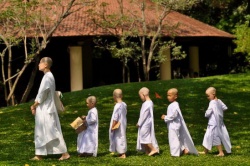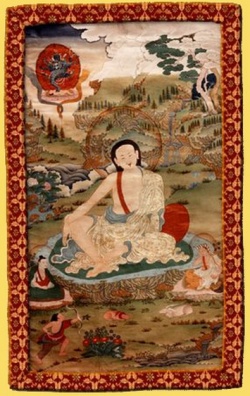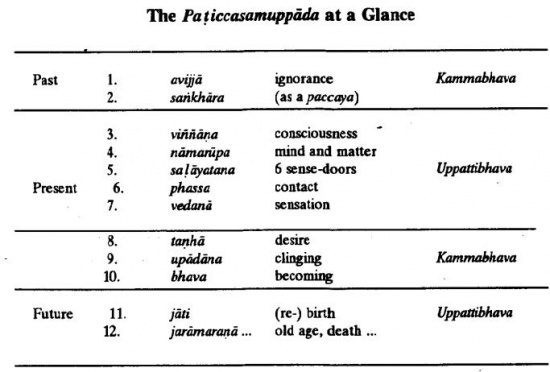The Cessation of Consciousness in Vipassanā Meditation by Ven. Bhikkhuni Anula Devi
The Cessation of Consciousness in Vipassanā Meditation
Ven. Bhikkhuni Anula Devi, Korea, PhD candidate of Postgraduate Institute of Pali and Buddhist Studies University of Kelaniya in Sri Lanka
There is suffering, there is cause
Most of us when we confront difficulties or problems attribute the reason to others or something else. Generally that is our first reaction. Because of YOU! We do not realize that this is a terrible accusation, if it is true. If we blame everything that happens to us on external causes, there will be no solution unless we kill or enslave or imprison all other beings, which we know to be totally impossible, but which is still being attempted in some parts of the world, though. In this regard we are right to refer to the story of Upatissa who became enlightened after receiving just one stanza from the Elder Assaji.[1] Below is that stanza:
- "Of all those things that from a cause arise,
- Tathāgata the cause thereof has told;
- And how they cease to be, that too he tells,
- This is the doctrine of the Great Recluse."
It is said that upon hearing the first two lines Upatissa had already attained the Path of stream-entry/sotāpatti, the first sainthood in Buddhism: It was the cause that brought everything here to the present. Then, instantly, everything becomes crystal clear and the question becomes the answer. Now we can infer if we want to have a good result we need to make a good cause or if we want to be free from the result we need to remove all causes. We now know the answer is – because of ME. “This being, that becomes; from the arising of this, that arise;
- This not being, that becomes not; from the ceasing of this, that ceases.”[2]
- Imasmiṃ sati, idaṃ hoti, Imassa uppādā, idaṃ uppajjati
- Imasmiṃ asati, idaṃ na hoti Imassa nirodhā, idaṃ nirujjhati
If there is suffering then there is cause. The Buddha explained how suffering arises in the cause and effect relationship i.e. causality/paṭiccasamuppāda showing the way of the arising of a whole mass of suffering:
- "When this is, that comes to be; with the arising of this, that arises; that is to say, from ignorance as condition (arises) formations; from formations as condition (arises) consciousness; from consciousness ..... name-and-form, from name-and-form ..... the six sense-spheres; from the six sense-spheres ...... contact; from contact ...... feeling; from feeling .... craving; from craving ..... grasping; from grasping ..... becoming; from becoming ...... birth; from birth as condition arise decay-and-death, sorrow, lamentation, pain, grief and despair. Such is the arising of this whole mass of suffering.[3]
The Buddha’s enlightenment was totally dependent on this causality. While He was observing this process sequentially (see diagram below) he understood this is the arising of suffering. In reverse order, cancelling one by one, he realized that this is the cessation of suffering.
Life starts with consciousness
As the paṭiccasamuppāda shows our present life starts with consciousness being a cause of a whole mass of suffering. Then what is life? The corpse also has eyes, nose, ears, tongue, and body, as we have. Then what is the difference between the dead body and the living body? The difference is that the living body can recognize things. Therefore life means recognizing external things. That function is attributed to consciousness in Buddhism.
When we see the 12 links of causality these external objects are not included until the 5th link of six sense-doors/saḷāyatana. But it is included in the 6th link of contact/phassa.
"Dependent on eye and forms, eye-consciousness arises. The meeting of the three is contact. / Cakkhuñca, paṭicca rūpe ca uppajjati cakkhuviññāṇaṃ tiṇṇaṃ saṅgati phasso.[4]
So with the appearance of viññāṇa/consciousness the objects too appear. In other words, the external objects are directly related to viññāṇa itself. If we put it in reverse it means without viññāṇa there will be no objects, no so called world. If so, are the objects out there or in the viññāṇa? This is often questioned in the tradition of Zen meditation. Is the stone in the garden inside the mind or outside the mind?
Then what are those external objects? They are “forms as eye objects”, “sounds as ear objects”, “smells as nose objects”, “tastes as tongue objects”, “and tangibles as body objects” and “thoughts as mind objects”. Before we proceed we’d better clarify what the world actually is. The Buddha defined the world like this:
- “I do proclaim that in this very fathom long body, with its perceptions and consciousness, is the world’s arising.”[5]
- “Wherever, Samiddhi, there is the eye, the visible forms, the visual consciousness and things perceptible with the visual consciousness, there is the world or the concept of it.”[6]
Even Einstein said this visible world is an optical illusion. According to neuro-sciences when we see the external object its shape is not ‘out there’ but is only a cluster of light. This light travels into the retina from which it refracts and turns into electrical signals which become information to the neuron of the brain cell, finally reaching the visual cortex. So what we are seeing is all in the visual cortex at the back of the brain. This is applicable to the other four senses, too. Thus the world is what our senses present to us.
To explain the relationship between the viññāṇa and the reality of external objects, we introduce the double slit experiment, the notable achievement in quantum physics. According to this discovery, when the observer sees the wave patterned electrons they change into particles which are the building blocks of this material reality. It means that upon participation of the observer – i.e. arising of consciousness – the material visible world is created. Amit Goswami[7] says that the world is made at every moment with our collective consciousness. German Physicist Max Planck[8] says:
- All matter originates and exists only by virtue of a force which brings the particle of an atom to vibration and holds this most minute solar system of the atom together.
- We must assume behind this force the existence of a conscious and intelligent mind. This mind is the matrix of all matter.
Then what would this state be like when we are free from suffering or without consciousness if it causes the entire world to suffer.
Beyond consciousness
In Vakkali Sutta we can find the consciousness-unestablished when the Buddha referred to Vakkali who died as an Arahant :
- “That, bhikkhus, is Mara the Evil One searching for the consciousness of the clansman Vakkali, wondering: ‘Where now has the consciousness of the clansman Vakkali been established?’ However, bhikkhus, with consciousness-unestablished (viññāṇam anidassanam), the clansman Vakkali has attained final Nibbana.”[9]
The monk who died as an Arahant, whose consciousness was no longer found, was the one who destroyed his root-cause of suffering. This is what the lower two lines of the above stanza mean: And how they cease to be, that too he tells, This is the doctrine of the Great Recluse.
It is said that the Buddha’s consciousness was not traceable even while he was still alive.
- But there is also a sense in which the phrase aptly describes the nature of the awakened mind here in this life. When his questioners try to pin the Buddha down about whether his consciousness survives after death, he rebukes them by saying that even here and now the consciousness of a Tathāgata is untraceable, since there is no means of measuring or knowing it.[10] The awakened mind is said to be unattached to anything in the world — like a bird that does not alight upon and thus get bound to any object of experience.[11]
Buddha attributed the suffering or unsatisfactoriness/dukkha in this world to the activity of the self-conscious mind leading to the generation of obsessions and bondage.[12] So it is clear that normal consciousness which rests on the data of sense-experience is the error itself and is responsible for all kinds of suffering creating this illusory material world.
Now we have to deal with consciousness.
How to deal with consciousness
The Buddha said that viññāṇa/consciousness should be understood and paññā should be developed. In order to understand the cessation of consciousness we again should keep in mind that consciousness is arising with the appearance of objects as we have been discussing. And the Buddha also explained the emergence of consciousness as a natural causal process denying that consciousness would emerge in the absence of the necessary conditions.[13]
In Kevatta Sutta, the Buddha said that with the cessation of consciousness everything comes to an end. There, these pāli words are used viññāṇassa nirodhena to denote the cessation of consciousness.
- “Consciousness-unestablished, infinite, luminous all around
- Here it is that earth and water, fire and wind, no footing find.
- Here again are long and short, subtle and gross, pleasant and unpleasant
- Name and form, all comes to an end without exceptions.
- With the cessation of consciousness each is here brought to an end.”
- ‘Viññāṇaṃ anidassanaṃ, anantaṃ sabbatopabhaṃ;
- Ettha āpo ca pathavī, tejo vāyo na gādhati.
- Ettha dīghañca rassañca, aṇuṃ thūlaṃ subhāsubhaṃ;
- Ettha nāmañca rūpañca, asesaṃ uparujjhati;
- Viññāṇassa nirodhena, etthetaṃ uparujjhatī’ti.
Through Vipassanā meditation we can possibly reach this state of the cessation of consciousness. This is our inheritance from the Buddha himself. Satipaṭṭhāna Sutta on which Vipassanā meditation is based instructs the meditator to observe all the objects in this way :
- “In this way he abides contemplating feelings as feelings internally, or he abides contemplating feelings as feelings externally, or he abides contemplating feelings as feelings both internally and externally. Or else he abides contemplating in feelings their arising factors, or he abides contemplating in feelings their vanishing factors, or he abides contemplating in feelings both their arising and vanishing factors. Or else mindfulness that ‘there is feeling’ is simply established in him to the extent necessary for the bare knowledge and mindfulness. And he abides independent, not clinging to anything in the world. That is how a bhikkhu abides contemplating feeling as feelings.”[14] (applicable to all the other objects)
Here, the instruction above says that we should observe firstly the arising of the object and secondly the vanishing of it, then thirdly both appearing and disappearing of that object. The most important point is that the meditator should clearly notice the disappearance of that very object at every moment. The clearer you see the object disappearing the closer you are to cessation state, because without the object consciousness cannot exist, as we can’t perceive what has already disappeared.
Here this specific consciousness which is observing the object is called sati/mindfulness. In practice sati closely observes the object and, as a rule, that object disappears. Just at the moment the object disappears, the sati which closely follows it, too, disappears, thus losing the object. As he lets go of self included in the objects, he touches the realm of cessation/so nirodhaṃ phussati.[15] The cessation of consciousness happens in a split second. The consciousness itself disappears, in the real sense it means the world, the self, All disappears. What is All here ? The All means the six internal and six external sense media.[16] This is called saḷāyatana nirodha/the cessation of six sense perceptions. This is the moment one enters the Path i.e. sotāpatti, first sainthood out of four levels of enlightenment in Buddhism.
In Kevatta Sutta the word ‘viññāṇaṃ anidassanaṃ is used to mean consciousness-unestablished. It does not partake in the All-Ness of the All.[17] In this it differs from the consciousness factor in dependent co-arising, which is defined in terms of the six sense media. Lying outside of time and space, it would also not come under the consciousness-aggregate, which covers all consciousness near and far; past, present, and future. However, the fact that it is outside of time and space [18] — in a dimension where there is no here, there, or in between,[19] no coming, no going, or staying.[20]
Somehow this state is difficult to understand for most people who haven’t experienced it as we can see in the dialogue between Mahā koṭṭhita and Sāriputta in Koṭṭhita Sutta. Here Mahā koṭṭhita was asking about the cessation of six contacts but Sāriputta did not allow him to approach in that manner conceptualising what should not be perceived conceptually.
- “Brother, when the six spheres of contact cease without residue, is there anything still left?" ……………………………………..
- "Brother, he who says: ‘when the six spheres of contact cease without residue there is still something left,’ is conceptualising what should not be proliferated conceptually...... (repeat with regard to the other three). Brother, whatever is the range of the six spheres of contact, that itself is the range of prolific conceptualisation. And whatever is the range of prolific conceptualisation, that itself is the range of the six spheres of contact. By the utter detachment from, and the cessation of the six spheres of contact, there comes to be the cessation, the allyment, of prolific conceptualisation.”
Interestingly, in Zen Buddhism, when those kind of things were asked the Zen master suddenly hit the questioner with a stick or gave a thundering cry.
During the Buddha’s time, the novices who entered the Saṅgha easily and normally attained sotāpatti/stream-entry. It seemed to be a common occurrence in the early Saṅgha. Sāriputta was particularly skilled at leading others to stream-entry.[21] We should remember that when the Buddha was about to pass away, he asked the monks whether they had any doubts about Dhamma but no one asked any questions.[22] It showed that they were all beyond the level of sotāpanna whose character is defined as the one who has no doubt in the Triple-Gem. Actually, at that time, when we said Sanghaṁ Saraṇaṁ Gacchāmi it meant the enlightened Saṅgha. This is because the Vipassanā meditation method is the perfect way to reach this state. If we follow it correctly we cannot not reach there.
Free from consciousness
But as sotāpanna’s cessation is split second for immediately consciousness returns then works as the normal six sense bases consciousness. As we glance at the Buddha’s words in Kevatta Sutta the Buddha’s consciousness is not traceable but until sotāpanna reaches the final attainment i.e. Arahant Phala, her/his consciousness is still traceable. So sotāpanna should continue to observe the object and drop it persistently because she/he is still sekha who needs much more practice until the final realization that she/he might need a maximum of seven lives. In fact, a stream-enterer can be living in negligence, such as when she or he neglects to regularly retire into seclusion for the purpose of meditative practice and, due to neglecting the practice, gains neither concentration nor deeper insight. [23] However, sotāpanna since she/he experiences total non-existence really understands what arises will cease. Understanding of causality forms one of the qualities of a stream-enterer and this mental state is irreversible.
Being detached, dropping the object, that moment is untraceable. Although the Buddha’s five aggregates headed by consciousness were still working after his complete Enlightenment, as the Buddha is always in that detached state, his consciousness is untraceable – this is called the Awakened state. So Enlightenment is not fantasy at all but somewhat palpable and even logical, happening neither in heaven nor in the temple nor in the Sutta but only in one’s own perceptive process.
Footnotes
- ↑ The Elder Assaji was the Buddha’s disciple. After that Upatissa entered the Buddha’s Saṅgha where he became the Buddha’s best disciple with the name of Sāriputta.
- ↑ S. 2.28
- ↑ M.III. Bahudhātuka S
- ↑ MN 18.
- ↑ A.N.II, 48
- ↑ S.N.IV, 39-40
- ↑ Amit Goswami is a theoretical nuclear physicist and member of The University of Oregon Institute for Theoretical Physics
- ↑ Max Planck, in full Max Karl Ernst Ludwig Planck (born April 23, 1858, Kiel, Schleswig [ Germany ]—died Oct. 4, 1947, Göttingen, W.Ger.), theoretical physicist who originated quantum theory, which won him the Nobel Prize for Physics in 1918.
- ↑ SN 22.87
- ↑ e.g. Sn 1074
- ↑ PTS: A III, 366 : Dhammika (excerpt) translated from the Pali by Andrew Olendzki. Foot note No 2
- ↑ D.11, p. 63.
- ↑ M. I. p. 257f.
- ↑ Bhikkhu Ñāṇamoli and Bhikkhu Bodhi, The Middle Length Discourses of the Buddha, Wisdom Publications Boston, 1995. p.150.
- ↑ Poṭṭhapāda Sutta. p.89
- ↑ SN 35.23
- ↑ MN49
- ↑ Here we can relate this to the question of Zen regarding the stone in the garden
- ↑ Ud 1.10
- ↑ Ud 8.1
- ↑ M. III, 248
- ↑ Mahāparinibbāna Sutta
- ↑ S. V, 398
Source
Ven. Bhikkhuni Anula Devi, Korea, PhD candidate of Postgraduate Institute of Pali and Buddhist Studies University of Kelaniya in Sri Lanka
The third International Conference Buddhism & Australia 2014

